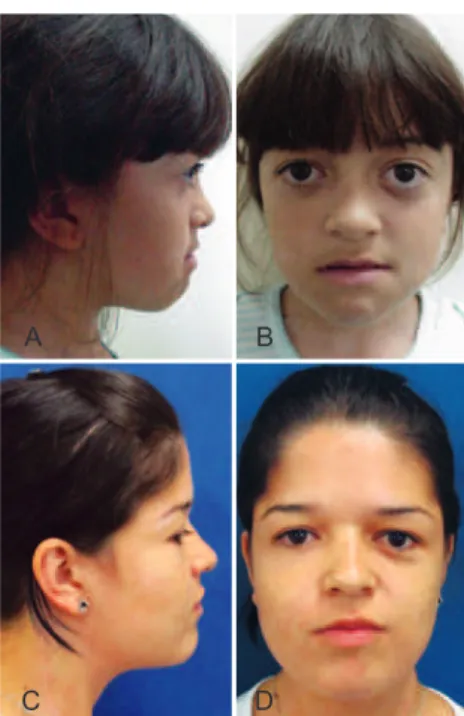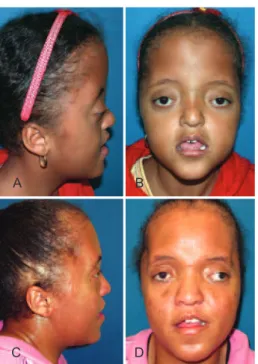Rev Bras Cir Plást. 2012;27(2):223-6 223
Age and indications for osteotomy for frontofacial advancement in patients with syndromic craniosynostosis
Age and indications for osteotomy for frontofacial
advancement in patients with syndromic
craniosynostosis
Idade e indicações de osteotomias para avanço frontofacial em pacientes
com craniossinostoses sindrômicas
ABSTRACT
Background: Craniofacial surgery has overcome many challenges since its initiation into clinical practice. Several technical issues have been addressed and the basic infrastructure
of the specialty has now been developed. At present, 25 years after the irst publications
on frontofacial advancement, questions still remain as to the appropriate age for surgery and the appropriate type of surgery that should be performed. The aim of this study was to evaluate patients surgically treated for syndromic craniosynostosis over the last 10 years at our institution. Methods: All syndromic patients who underwent monobloc frontofacial advancement or only isolated facial advancement from 2001 to 2011were selected. Out of 70 patients in total, 56 underwent monobloc frontofacial advancement and 14 underwent facial advancement after fronto-orbital remodeling. All data concerning these patients were
correlated with patient age and inal result. Moreover, age at surgery, complications, and inal results were correlated with the main preexisting problems. Results: Final results for syndromic patients varied, depending on the syndrome and the age at which the procedure
was performed. Monobloc frontofacial advancements had a low index of immediate pos -toperative complications, but there was a clear need for further procedures at the time of
inal facial growth. The index of positive outcome was higher in patients who underwent
surgery at an older age. Conclusions: In cases of severe craniosynostosis with functional problems, monobloc frontofacial advancement is still the best therapeutic option.
Keywords: Craniosynostoses/surgery. Craniofacial abnormalities. Outcome assessment.
RESUMO
Introdução: Desde o início da Cirurgia Craniofacial, muitos desaios foram ultrapassados. Problemas operatórios técnicos e de infraestrutura básica de atendimento especializado foram solucionados. Agora, 25 anos após as publicações iniciais dos avanços frontofaciais, há ainda algumas dúvidas quanto às indicações precisas da idade e do tipo de cirurgia a ser realizada. O objetivo deste estudo foi avaliar a evolução de pacientes submetidos a trata-mento de craniossinostoses sindrômicas operados nos últimos 10 anos em nossa instituição. Método: Todos os pacientes sindrômicos submetidos a avanço frontofacial em monobloco ou somente facial isolado foram selecionados no período de 2001 a 2011. Foram selecionados 70 pacientes, 56 submetidos a avanço frontofacial em monobloco e 14, a avanço facial após remodelagem frontorbitária prévia. Todos os dados referentes a esses pacientes foram
corre-Work conducted at the Plastic Surgery Unit, Faculdade
de Medicina da Universidade de São Paulo (Faculty of Medicine,
University of São Paulo), São Paulo, SP, Brazil.
Submitted to SGP (Sistema de
Gestão de Publicações/Manager
Publications System) of RBCP (Revista Brasileira de Cirurgia Plástica/Brazilian Journal of Plastic Surgery).
Article received: February 21, 2012 Article accepted: June 14, 2012
1. Associate Professor at Faculdade de Medicina da Universidade de São Paulo (Faculty of Medicine, University of São Paulo) – FMUSP, full member of the Sociedade Brasileira de Cirurgia Plástica (Brazilian Society of Plastic Surgery) – SBCP, São Paulo, SP, Brazil.
2. Associate Professor of Neurosurgery at FMUSP, São Paulo, SP, Brazil.
3. Associate Professor of Plastic Surgery at FMUSP, full member of the SBCP, São Paulo, SP, Brazil.
4. Assistant Physician in the Department of Plastic Surgery of the FMUSP, full member of the SBCP, São Paulo, SP, Brazil. Nivaldo aloNso1
HamiltoN matusHita2
dov CHarles GoldeNberG3
eNdriGo oliveira bastos4
Rev Bras Cir Plást. 2012;27(2):223-6 224
Alonso N et al.
lacionados, avaliando a idade e o resultado inal. Os pacientes foram selecionados de acordo com idade à época da cirurgia, complicações existentes e resultados inais correlacionados com os principais problemas existentes previamente. Resultados: Os pacientes sindrômicos
apresentaram graus variados de resultados inais, dependendo da síndrome e da idade de realização do procedimento. Os avanços frontofaciais em monobloco apresentaram baixo índice de complicações pós-operatórias imediatas, porém icou demonstrada a necessidade de procedimentos futuros ao inal do crescimento facial. Nos pacientes submetidos a cirur -gias mais tardiamente, o índice de resultados positivos foi maior. Conclusões: Nos casos de craniossinostoses graves, com problemas funcionais, a indicação de avanço frontofacial em monobloco continua sendo a melhor opção terapêutica.
Descritores: Craniossinostoses/cirurgia. Anormalidades craniofaciais. Avaliação de resultados.
INTRODUCTION
Premature closing of the cranial sutures in children leads to profound craniofacial alterations, both aesthetic and
func-tional. Complex craniosynostosis, involving the closure of
several cranial and facial sutures, interferes with vital func-tions, and the craniofacial skeleton becomes compromised
in 3 dimensions: cerebral expansion is restricted; protection of the ocular globe is deicient; and, most importantly, brea
-thing is compromised.
The treatments that have been proposed to date aim at re -leasing the cranial sutures, with bone remodeling to allow for
cerebral expansion; this is occasionally combined with orbital
remodeling to protect the ocular globe. Additionally, in cranio-synostosis with respiratory involvement, which is generally
more serious, complex frontofacial advance ment is prematu -rely advised. The greatest dificulty is in precisely identifying the perfect age to perform these surgical pro cedures. Although there are centers that perform these procedures in younger patients, others perform the procedures in older individuals because of the higher risk for complications associated with performing these operations on younger patients1-4.
The aim of this study was to evaluate the clinical evolu-tion of patients treated for syndromic craniosynostosis who underwent surgery at our institution over the past 10 years.
METHOD
Seventy patients with syndromic craniosynostosis who we re operated on from 2001 to 2011 were analyzed in this study. The patients were operated on at different centers by the senior author (NA).
Among these 70 patients, 56 were subjected to monobloc frontofacial advancement and 14 to facial advancement with osteotomy type Le Fort III.
The patients were distributed into 3 groups according to age: younger than 5 years (GI), 5 to 12 years (G2), and older than 12 years (G3).
The correlations among the diagnosis, age, and
complica-tions associated with each type of procedure were examined.
Evaluation of results was conducted according to the position of the medial third of the face and orbits, as well as the presence of breathing problems after surgical correction. Patients operated upon in the last few years were not included
in the inal evaluation, which was limited to the 26 patients
with a postoperative follow-up period of at least 5 years.
RESULTS
The distribution of patients according to diagnosis and
procedure is shown in Table 1; patients suffering from Crou
-zon and Apert syndromes were predominant.
The groups of patients according to age are shown in Table 2, indicating that the majority of monobloc facial advancements were performed on patients between the ages of 5 and 12 years.
The average age of patients who underwent monobloc frontofacial advancement was 6.97 years and ranged from 9 months to 15 years. For frontal advancements, the mean age of patients was 17.21 years and ranged from 10 to 25 years.
Complications related to the surgery are illustrated in Table 3.
The results of the postoperative evaluation are summa-rized in Table 4 and showed that retrusion of the medial third of the face was found in 18 patients, all of whom were subjected to monobloc frontofacial advancements.
Table 1 – Case distribution according to diagnosis and procedure.
Diagnosis Monobloc Le Fort III Total
Crouzon syndrome 32 8 40
Apert syndrome 18 6 24
Pfeiffer syndrome 5 __ 5
Rev Bras Cir Plást. 2012;27(2):223-6 225
Age and indications for osteotomy for frontofacial advancement in patients with syndromic craniosynostosis
Eight patients required tracheostomy (G1 and G2); re
mo-val was possible in 6 of the cases.
Figures 1 to 3 illustrate some of the cases reported in this study.
DISCUSSION
Since its beginnings in the pioneering work of Paul Tessier, the field of craniofacial surgery has shown that there is hope for the treatment of severe facial deformi ties. In the past 15 years, with the development of frontofa -cial advan cements using fa-cial distraction, there has been a pronoun ced decrease in complications related to these pro cedures, which has encouraged many surgeons to use them. However, large osteotomies in immature skeletons
Table 2– Case distribution according to age at the time of the procedure.
Age range Monobloc Le Fort III Total
< 5 years (Group 1) 14 __ 14
5-12 years (Group 2) 39 __ 39
> 12 years (Group 3) 3 14 17
Total 56 14 70
Table 3– Observed surgical complications.
Complications n = 26
Cerebrospinal luid istula 3 (Group 2)
Infection 1 (Group 2)
Temporary vision problems 1 (Group 2) Displaced bone fracture 3 (Group 2) Breaking of distractor 3 (Group 2)
n = number of patients.
Table 4– Late postoperative results.
Unsatisfactory
results n = 26 Syndrome
Ocular protrusion (Groups 1 and 2)
1 1
Apert syndrome Crouzon syndrome
Face retrusion (Groups 1 and 2)
4 10
3 1
Apert syndrome Crouzon syndrome
Pfeiffer syndrome Saethre-Chotzen syndrome Breathing problems
(Group 2) 2 Crouzon syndrome
n = number of patients.
Figure 1 – Patient with Crouzon syndrome who underwent previous fronto-orbital advance. In A and B, lateral and front views, respectively, in pre-operative facial advancement Le Fort III type. In
C and D, lateral and front views, respectively, in the postoperative period of 10 years of facial advancement Le Fort III type.
A
C
B
D
Figure 2 – Patient with Crouzon syndrome. In A and B, lateral and front views, respectively, preoperatively fontofacial monobloc advancement, demonstrating severe exophthalmos with retrusion of the midface. In C and D, lateral and front views, respectively, in the postoperative period of 7 years, demonstrating maintenance of the
advancement of the orbital region.
A
C
B
Rev Bras Cir Plást. 2012;27(2):223-6 226
Alonso N et al.
Figure 3 – Patient with Apert syndrome. In A and B, lateral and front views, respectively, preoperatively frontofacial monobloc advancement, showing hypoplasia of the periorbital region and retrusion of the midface. In C and D, lateral and front views,
respectively, in the postoperative period of 10 years, demonstrating maintenance of the advance obtained.
A
C
B
D
must start from the pre mise of evaluating the growth of the skeleton.
In the most dramatic clinical situations, with the pre -sence of tracheostomy and pronounced ocular protrusion (generally in syndromic patients), it is our opinion that, to immediately improve the clinical situation, earlier and more aggressive facial advancements are indicated (mono-bloc frontofacial advancements), even in the absence of
adequate posterior growth of the medial third of the face. However, because of the inadequate facial growth in pa -tients subjected to large advancements before the age of 5 years (G1), as well as in the 5- to 12-year-old group (G2), it is important to consider, whenever possible, postponing facial advancements until after the age of 12. Although the patients operated upon for facial advancement also had alterations in facial occlusion, none showed retrusion of the medial third when operated upon after the age of 12.
CONCLUSIONS
The low rate of perioperative and immediate postope -rative complications in frontofacial osteotomies (monobloc frontofacial advancements) is encouraging, and results in
the increased use of these procedures; however, the need for
further operations after skeletal maturity strongly suggests that these procedures may eventually be performed in indi -viduals at a older age, depending on clinical priorities.
Emphasis should primarily be given to functional pro -blems but, even in less serious cases, patients with syndromic craniosynostosis undoubtedly have problems with the growth of the bones of the face.
REFERENCES
1. Arnaud E, Marchac D, Renier D. Reduction of morbidity of the frontofa -cial monobloc advancement in children by the use of internal distraction.
Plast Reconstr Surg. 2007;120(4):1009-26.
2. Fearon JA. Halo distraction of the Le Fort III in syndromic
cranio-synostosis: a long-term assessment. Plast Reconstr Surg. 2005;115(6):
1524-36.
3. Tessier P, Guiot G, Rougerie J, Delbet JP, Pastoriza J.
Cranio-naso-orbito-fa cial osteotomies. Hypertelorism. Ann Chir Plast. 1967;12(2):103-18. 4. Polley JW, Figueroa AA. Management of severe maxillary deiciency
in childhood and adolescence through distraction osteogenesis with
an external, adjustable, rigid distraction device. J Craniofac Surg. 1997;8(3):181-6.
Correspondence to: Nivaldo Alonso


